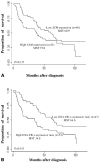Prognostic significance of ataxia-telangiectasia mutated, DNA-dependent protein kinase catalytic subunit, and Ku heterodimeric regulatory complex 86-kD subunit expression in patients with nonsmall cell lung cancer
- PMID: 18457328
- PMCID: PMC3384998
- DOI: 10.1002/cncr.23533
Prognostic significance of ataxia-telangiectasia mutated, DNA-dependent protein kinase catalytic subunit, and Ku heterodimeric regulatory complex 86-kD subunit expression in patients with nonsmall cell lung cancer
Abstract
Background: The double-strand break (DSB) repair capacity has been implicated in the survival of patients in several cancer types. However, little is known about the prognostic importance of the key DSB repair genes-ataxia-telangiectasia mutated (ATM), DNA-dependent protein kinase catalytic subunit (DNA-PKcs), and the Ku heterodimeric regulatory complex 86-kD subunit (Ku80)-in nonsmall cell lung cancer (NSCLC). To address this issue, the authors determined the messenger RNA (mRNA) expression of these genes in patients NSCLC and assessed their prognostic relevance.
Methods: mRNA expression levels of ATM, DNA-PKcs, and Ku80 were measured in tumor and adjacent normal tissues from 140 patients with NSCLC by using quantitative real-time polymerase chain reaction analysis. Then, a Cox proportional hazards regression model and Kaplan-Meier plots were used to evaluate the association between the tumor:normal (T/N) expression ratios of the 3 genes and the overall survival rate and duration in patients with NSCLC.
Results: mRNA expression of ATM and DNA-PKcs, but not of Ku80, was significantly higher in tumor tissues than in adjacent normal tissues (P=.003 and P<.001, respectively). The high T/N expression ratios of ATM and DNA-PKcs were associated significantly with a 1.82-fold increased risk of death (95% confidence interval, 1.05-2.70) and a 2.13-fold increased risk of death (95% confidence interval, 1.21-3.76), respectively. However, no significant association with risk was observed for Ku80. Kaplan-Meier analyses revealed that patients with high T/N expression ratios of ATM or DNA-PKcs had notably shorter median survival than patients with low ratios.
Conclusions: The current findings suggested that the T/N expression ratios of ATM and DNA-PKcs may be useful for identifying NSCLC patients with a poor prognosis who may benefit from more aggressive therapy.
Copyright (c) 2008 American Cancer Society.
Figures
References
-
- Jemal A, Siegel R, Ward E, Murray T, Xu J, Thun MJ. Cancer statistics, 2007. CA Cancer J Clin. 2007;57:43–66. - PubMed
-
- Niklinski J, Niklinska W, Laudanski J, Chyczewska E, Chyc-zewski L. Prognostic molecular markers in non-small cell lung cancer. Lung Cancer. 2001;34(suppl 2):S53–S58. - PubMed
-
- van Gent DC, Hoeijmakers JH, Kanaar R. Chromosomal stability and the DNA double-stranded break connection. Nat Rev Genet. 2001;2:196–206. - PubMed
-
- Khanna KK, Jackson SP. DNA double-strand breaks: signaling, repair and the cancer connection. Nat Genet. 2001;27:247–254. - PubMed
-
- Helleday T, Lo J, van Gent DC, Engelward BP. DNA double-strand break repair: from mechanistic understanding to cancer treatment. DNA Repair (Amst) 2007;6:923–935. - PubMed
Publication types
MeSH terms
Substances
Grants and funding
LinkOut - more resources
Full Text Sources
Medical
Research Materials
Miscellaneous


